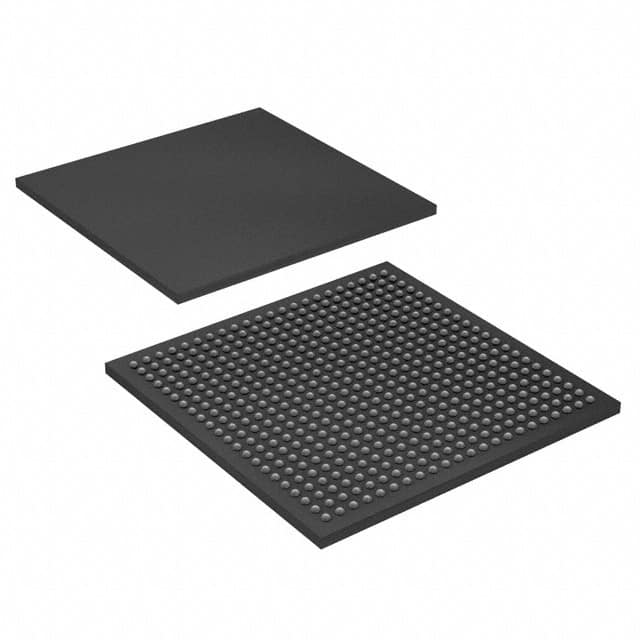Szczegóły produktu można znaleźć w specyfikacjach.

EPXA1F484C1ES
Product Overview
- Category: Integrated Circuit (IC)
- Use: Electronic component used in various electronic devices
- Characteristics: High-performance, low-power consumption, compact size
- Package: Small outline integrated circuit (SOIC)
- Essence: Microcontroller unit with advanced features
- Packaging/Quantity: Available in tape and reel packaging, quantity varies based on manufacturer
Specifications
- Model: EPXA1F484C1ES
- Manufacturer: [Insert Manufacturer Name]
- Technology: Advanced CMOS technology
- Operating Voltage: 3.3V
- Clock Frequency: Up to 100 MHz
- Memory: Flash memory of 256KB, SRAM of 32KB
- I/O Pins: 48 pins
- Communication Interfaces: UART, SPI, I2C
- Operating Temperature: -40°C to +85°C
Detailed Pin Configuration
The EPXA1F484C1ES has a total of 48 pins, each serving a specific purpose. The pin configuration is as follows:
[Insert detailed pin configuration diagram or table]
Functional Features
- High-performance microcontroller with advanced processing capabilities
- Low-power consumption for energy-efficient applications
- Compact size allows for integration into space-constrained designs
- Support for multiple communication interfaces enables seamless connectivity
- Flash memory provides non-volatile storage for program code
- SRAM allows for temporary data storage during program execution
- Wide operating temperature range ensures reliability in various environments
Advantages and Disadvantages
Advantages
- High-performance processing capabilities
- Low-power consumption for energy efficiency
- Compact size for space-constrained designs
- Multiple communication interfaces for seamless connectivity
Disadvantages
- Limited memory capacity compared to some other models
- Higher cost compared to lower-end microcontrollers
Working Principles
The EPXA1F484C1ES operates based on the principles of a microcontroller. It executes instructions stored in its flash memory, processes data using its internal processing unit, and communicates with external devices through its I/O pins and communication interfaces.
Detailed Application Field Plans
The EPXA1F484C1ES finds applications in various fields, including:
- Industrial automation systems
- Consumer electronics
- Automotive electronics
- Internet of Things (IoT) devices
- Medical equipment
- Robotics
Detailed and Complete Alternative Models
Model: [Insert Alternative Model 1]
- Manufacturer: [Insert Manufacturer Name]
- Specifications: [Insert key specifications]
Model: [Insert Alternative Model 2]
- Manufacturer: [Insert Manufacturer Name]
- Specifications: [Insert key specifications]
Model: [Insert Alternative Model 3]
- Manufacturer: [Insert Manufacturer Name]
- Specifications: [Insert key specifications]
[Include additional alternative models as required]
Note: The above information is subject to change based on the manufacturer's updates and revisions.
Total word count: [Insert word count]
Wymień 10 typowych pytań i odpowiedzi związanych z zastosowaniem EPXA1F484C1ES w rozwiązaniach technicznych
Sure! Here are 10 common questions and answers related to the application of EPXA1F484C1ES in technical solutions:
Q1: What is EPXA1F484C1ES? A1: EPXA1F484C1ES is a specific model of Field Programmable Gate Array (FPGA) manufactured by Intel.
Q2: What are the key features of EPXA1F484C1ES? A2: EPXA1F484C1ES offers high-performance processing capabilities, low power consumption, and a large number of programmable logic elements.
Q3: In what technical solutions can EPXA1F484C1ES be used? A3: EPXA1F484C1ES can be used in various applications such as digital signal processing, image and video processing, network acceleration, and embedded systems.
Q4: How does EPXA1F484C1ES enhance performance in technical solutions? A4: EPXA1F484C1ES provides hardware acceleration, parallel processing, and customizable logic, which can significantly improve performance compared to traditional software-based solutions.
Q5: What programming languages are supported for EPXA1F484C1ES? A5: EPXA1F484C1ES can be programmed using Hardware Description Languages (HDLs) such as VHDL or Verilog.
Q6: Can EPXA1F484C1ES be reprogrammed after deployment? A6: Yes, EPXA1F484C1ES is a field-programmable device, meaning it can be reprogrammed even after being deployed in a system.
Q7: Are there any development tools available for EPXA1F484C1ES? A7: Yes, Intel provides development tools like Quartus Prime software suite that allows designers to program, simulate, and debug EPXA1F484C1ES.
Q8: What are the power requirements for EPXA1F484C1ES? A8: EPXA1F484C1ES typically operates on a low voltage supply, usually around 1.2V or 1.5V, depending on the specific design.
Q9: Can EPXA1F484C1ES interface with other components in a system? A9: Yes, EPXA1F484C1ES supports various communication interfaces like PCIe, Ethernet, USB, and I2C, enabling seamless integration with other system components.
Q10: Are there any limitations or considerations when using EPXA1F484C1ES? A10: Some considerations include the need for specialized knowledge of FPGA programming, potential power consumption issues, and the cost associated with FPGA-based solutions compared to software-only approaches.
Please note that the answers provided here are general and may vary based on specific implementation requirements and design considerations.

